Controlling Spontaneous Emission from Perovskite Nanocrystals with Metal–Emitter–Metal Nanostructures
Abstract
:1. Introduction
2. Materials and Methods
3. Results and Discussion
4. Conclusions
Supplementary Materials
Author Contributions
Funding
Acknowledgments
Conflicts of Interest
References
- Dai, X.; Zhang, Z.; Jin, Y.; Niu, Y.; Cao, H.; Liang, X.; Chen, L.; Wang, J.; Peng, X. Solution-Processed, High-Performance Light-Emitting Diodes Based on Quantum Dots. Nature 2014, 515, 96–99. [Google Scholar] [CrossRef] [PubMed]
- Abate, A.; Correa-Baena, J.P.; Saliba, M.; Su’ait, M.S.; Bella, F. Perovskite Solar Cells: From the Laboratory to the Assembly Line. Chem. A Eur. J. 2018, 24, 3083–3100. [Google Scholar] [CrossRef] [PubMed]
- Birowosuto, M.D.; Cortecchia, D.; Drozdowski, W.; Brylew, K.; Lachmanski, W.; Bruno, A.; Soci, C. X-Ray Scintillation in Lead Halide Perovskite Crystals. Sci. Rep. 2016, 6, 37254. [Google Scholar] [CrossRef] [PubMed] [Green Version]
- Xie, A.; Nguyen, T.H.; Hettiarachchi, C.; Witkowski, M.E.; Drozdowski, W.; Birowosuto, M.D.; Wang, H.; Dang, C. Thermal Quenching and Dose Studies of X-Ray Luminescence in Single Crystals of Halide Perovskites. J. Phys. Chem. C 2018, 122, 16265–16273. [Google Scholar] [CrossRef]
- Chen, Q.; Wu, J.; Ou, X.; Huang, B.; Almutlaq, J.; Zhumekenov, A.A.; Guan, X.; Han, S.; Liang, L.; Yi, Z.; et al. All-Inorganic Perovskite NC Scintillators. Nature 2018, 561, 88–93. [Google Scholar] [CrossRef] [PubMed]
- Birowosuto, M.D.; Dorenbos, P.; van Eijk, C.W.E.; Krämer, K.W.; Güdel, H.U. Güdel. Scintillation and Luminescence Properties of Ce3+ Doped Ternary Cesium Rare-Earth Halides. Phys. Status Solidi A 2007, 204, 850–860. [Google Scholar] [CrossRef]
- Zhou, C.; Lin, H.; He, Q.; Xu, L.; Worku, M.; Chaaban, M.; Lee, S.; Shi, X.; Du, M.H.; Ma, B. Low Dimensional Metal Halide Perovskites and Hybrids. Mater. Sci. Eng. R Rep. 2019, 137, 38–65. [Google Scholar] [CrossRef]
- Wu, L.; Chen, K.; Huang, W.; Lin, Z.; Zhao, J.; Jiang, X.; Ge, Y.; Zhang, F.; Xiao, Q.; Guo, Z.; et al. Perovskite Cspbx3: A Promising Nonlinear Optical Material and Its Applications for Ambient All-Optical Switching with Enhanced Stability. Adv. Opt. Mater. 2018, 6, 1800400. [Google Scholar] [CrossRef]
- Gholipour, B.; Adamo, G.; Cortecchia, D.; Krishnamoorthy, H.N.; Birowosuto, M.D.; Zheludev, N.I.; Soci, C. Organometallic Perovskite Metasurfaces. Adv. Mater. 2017, 29, 201604268. [Google Scholar] [CrossRef]
- Hou, S.; Xie, A.; Xie, Z.; Tobing, L.Y.; Zhou, J.; Tjahjana, L.; Yu, J.; Hettiarachchi, C.; Zhang, D.; Dang, C.; et al. Concurrent Inhibition and Redistribution of Spontaneous Emission from All Inorganic Perovskite Photonic Crystals. ACS Photonics 2019, 6, 1331–1337. [Google Scholar] [CrossRef]
- Hou, S.; Birowosuto, M.D.; Umar, S.; Anicet, M.A.; Tay, R.Y.; Coquet, P.; Tay, B.K.; Wang, H.; Teo, E.H.T. Localized Emission from Laser-Irradiated Defects in 2d Hexagonal Boron Nitride. 2D Mater. 2017, 5, 015010. [Google Scholar] [CrossRef]
- Birowosuto, M.D.; Yokoo, A.; Zhang, G.; Tateno, K.; Kuramochi, E.; Taniyama, H.; Takiguchi, M.; Notomi, M. Movable High-Q Nanoresonators Realized by Semiconductor Nanowires on a Si Photonic Crystal Platform. Nat. Mater. 2014, 13, 279–285. [Google Scholar] [CrossRef] [PubMed]
- Birowosuto, M.D.; Yokoo, A.; Taniyama, H.; Kuramochi, E.; Takiguchi, M.; Notomi, M. Design for Ultrahigh-Q Position-Controlled Nanocavities of Single Semiconductor Nanowires in Two-Dimensional Photonic Crystals. J. Appl. Phys. 2012, 112, 10. [Google Scholar] [CrossRef]
- Birowosuto, M.D.; Skipetrov, S.E.; Vos, W.L.; Mosk, A.P. Observation of Spatial Fluctuations of the Local Density of States in Random Photonic Media. Phys. Rev. Lett. 2010, 105, 013904. [Google Scholar] [CrossRef] [Green Version]
- Sapienza, L.; Thyrrestrup, H.; Stobbe, S.; Garcia, P.D.; Smolka, S.; Lodahl, P. Cavity Quantum Electrodynamics with Anderson-Localized Modes. Science 2010, 327, 1352. [Google Scholar] [CrossRef] [Green Version]
- Farahani, J.N.; Pohl, D.W.; Eisler, H.J.; Hecht, B. Single Quantum Dot Coupled to a Scanning Optical Antenna: A Tunable Superemitter. Phys. Rev. Lett. 2005, 95, 017402. [Google Scholar] [CrossRef]
- Gökbulut, B.; Yartaşı, E.; Sunar, E.; Kalaoglu-Altan, O.I.; Gevrek, T.N.; Sanyal, A.; Incı, M.N. Humidity Induced Inhibition and Enhancement of Spontaneous Emission of Dye Molecules in a Single Peg Nanofiber. Opt. Mater. Express 2018, 8, 568–580. [Google Scholar] [CrossRef]
- Gökbulut, B.; Inanç, A.; Topcu, G.; Guner, T.; Demir, M.M.; Inci, M.N. Enhancement of the Spontaneous Emission Rate of Perovskite Nanowires Coupled into Cylindrical Hollow Nanocavities Formed on the Surface of Polystyrene Microfibers. J. Phys. Chem. C 2019, 123, 9343–9351. [Google Scholar] [CrossRef]
- Protesescu, L.; Yakunin, S.; Bodnarchuk, M.I.; Krieg, F.; Caputo, R.; Hendon, C.H.; Yang, R.X.; Walsh, A.; Kovalenko, M.V. NCs of Cesium Lead Halide Perovskites (Cspbx3, X = Cl, Br, and I): Novel Optoelectronic Materials Showing Bright Emission with Wide Color Gamut. Nano Lett. 2015, 15, 3692–3696. [Google Scholar] [CrossRef] [Green Version]
- Chin, X.Y.; Perumal, A.; Bruno, A.; Yantara, N.; Veldhuis, S.A.; Martínez-Sarti, L.; Chandran, B.; Chirvony, V.; Lo, A.S.Z.; So, J.; et al. Self-Assembled Hierarchical Nanostructured Perovskites Enable Highly Efficient Leds Via an Energy Cascade. Energy Environ. Sci. 2018, 11, 1770–1778. [Google Scholar] [CrossRef]
- Akselrod, G.M.; Argyropoulos, C.; Hoang, T.B.; Ciracì, C.; Fang, C.; Huang, J.; Smith, D.R.; Mikkelsen, M.H. Probing the Mechanisms of Large Purcell Enhancement in Plasmonic Nanoantennas. Nat. Photonics 2014, 8, 835–840. [Google Scholar] [CrossRef] [Green Version]
- Hoang, T.B.; Akselrod, G.M.; Argyropoulos, C.; Huang, J.; Smith, D.R.; Mikkelsen, M.H. Ultrafast Spontaneous Emission Source Using Plasmonic Nanoantennas. Nat. Commun. 2015, 6, 7788. [Google Scholar] [CrossRef] [PubMed]
- Saleem, U.; Permatasari, F.A.; Iskandar, F.; Ogi, T.; Okuyama, K.; Darma, Y.; Zhao, M.; Loh, K.P.; Rusydi, A.; Coquet, P.; et al. Surface Plasmon Enhanced Nitrogen-Doped Graphene Quantum Dot Emission by Single Bismuth Telluride Nanoplates. Adv. Opt. Mater. 2017, 5, 201700176. [Google Scholar] [CrossRef]
- Dayal, G.; Solanki, A.; Chin, X.Y.; Sum, T.C.; Soci, C.; Singh, R. High-Q Plasmonic Infrared Absorber for Sensing of Molecular Resonances in Hybrid Lead Halide Perovskites. J. Appl. Phys. 2017, 122, 073101. [Google Scholar] [CrossRef]
- Drexhage, K.H. Influence of a Dielectric Interface on Fluorescence Decay Time. J. Lumin. 1970, 1–2, 693–701. [Google Scholar] [CrossRef]
- Chance, R.R.; Prock, A.; Silbey, R. Molecular Fluorescence and Energy Transfer near Interfaces. Adv. Chem. Phys. 1978, 37, 1–65. [Google Scholar]
- Barnes, W.L. Electromagnetic Crystals for Surface Plasmon Polaritons and the Extraction of Light from Emissive Devices. J. Lightwave Technol. 1999, 17, 2170–2182. [Google Scholar] [CrossRef]
- Jun, Y.C.; Kekatpure, R.D.; White, J.S.; Brongersma, M.L. Nonresonant Enhancement of Spontaneous Emission in Metal-Dielectric-Metal Plasmon Waveguide Structures. Phys. Rev. B 2008, 78, 153111. [Google Scholar] [CrossRef] [Green Version]
- Xu, Y.; Vučković, J.S.; Lee, R.K.; Painter, O.J.; Scherer, A.; Yariv, A. Finite-Difference Time-Domain Calculation of Spontaneous Emission Lifetime in a Microcavity. J. Opt. Soc. Am. B 1999, 16, 465–474. [Google Scholar] [CrossRef] [Green Version]
- Johnson, P.B.; Christy, R.W. Optical Constants of the Noble Metals. Phys. Rev. B 1972, 6, 4370–4379. [Google Scholar] [CrossRef]
- Cooper, B.R.; Ehrenreich, H.; Philipp, H.R. Optical Properties of Noble Metals. II. Phys. Rev. 1965, 138, A494–A507. [Google Scholar] [CrossRef]
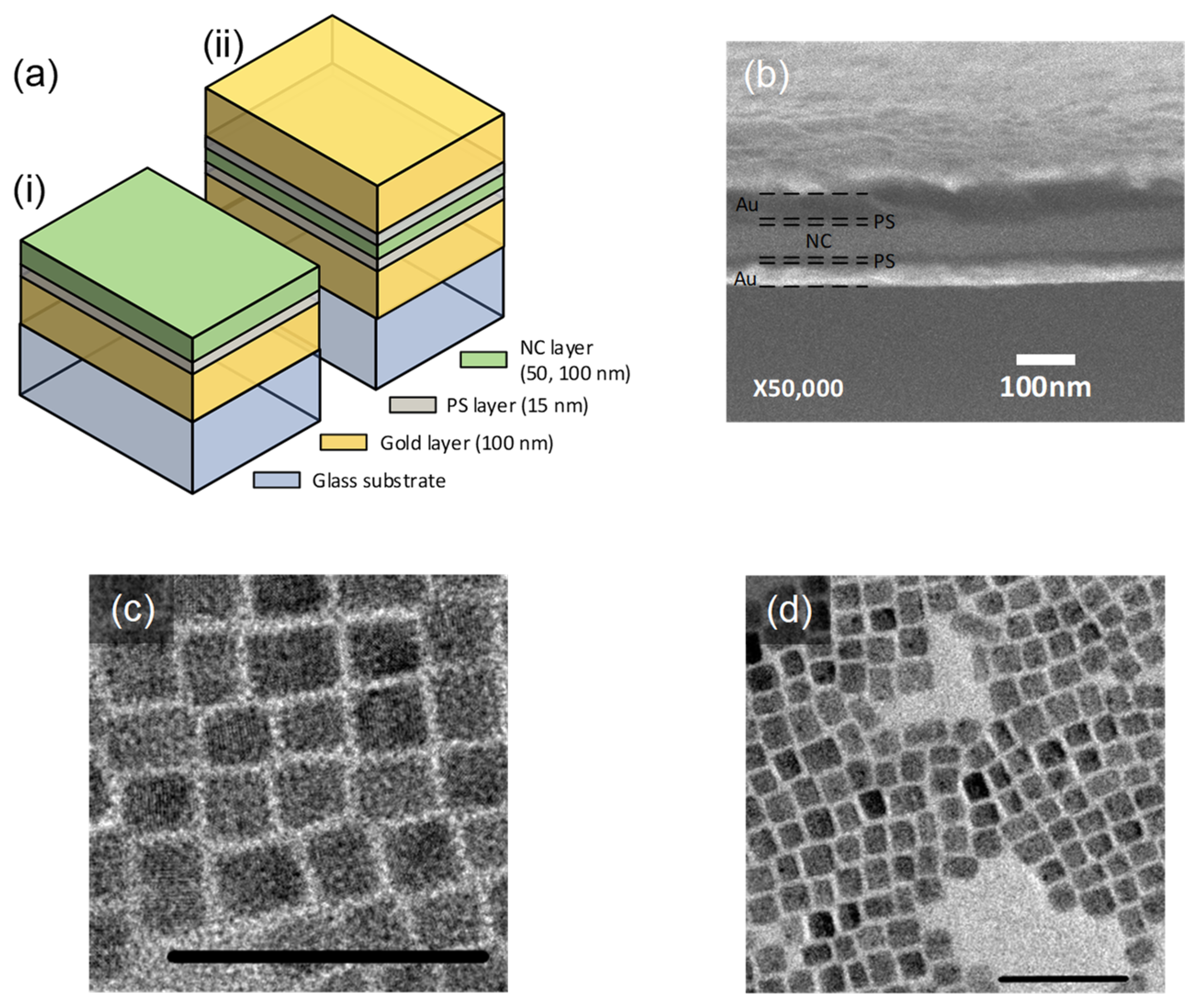
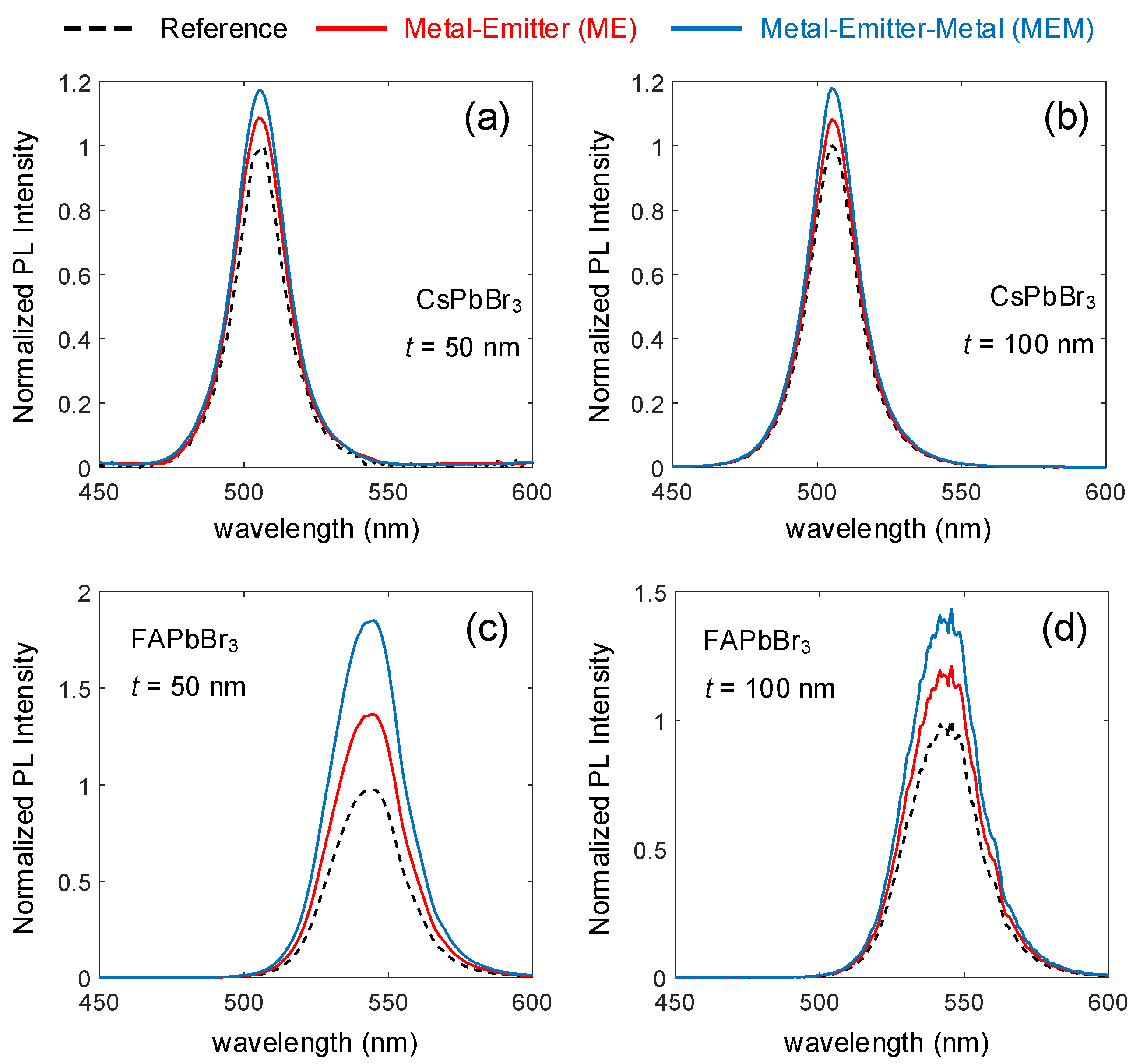
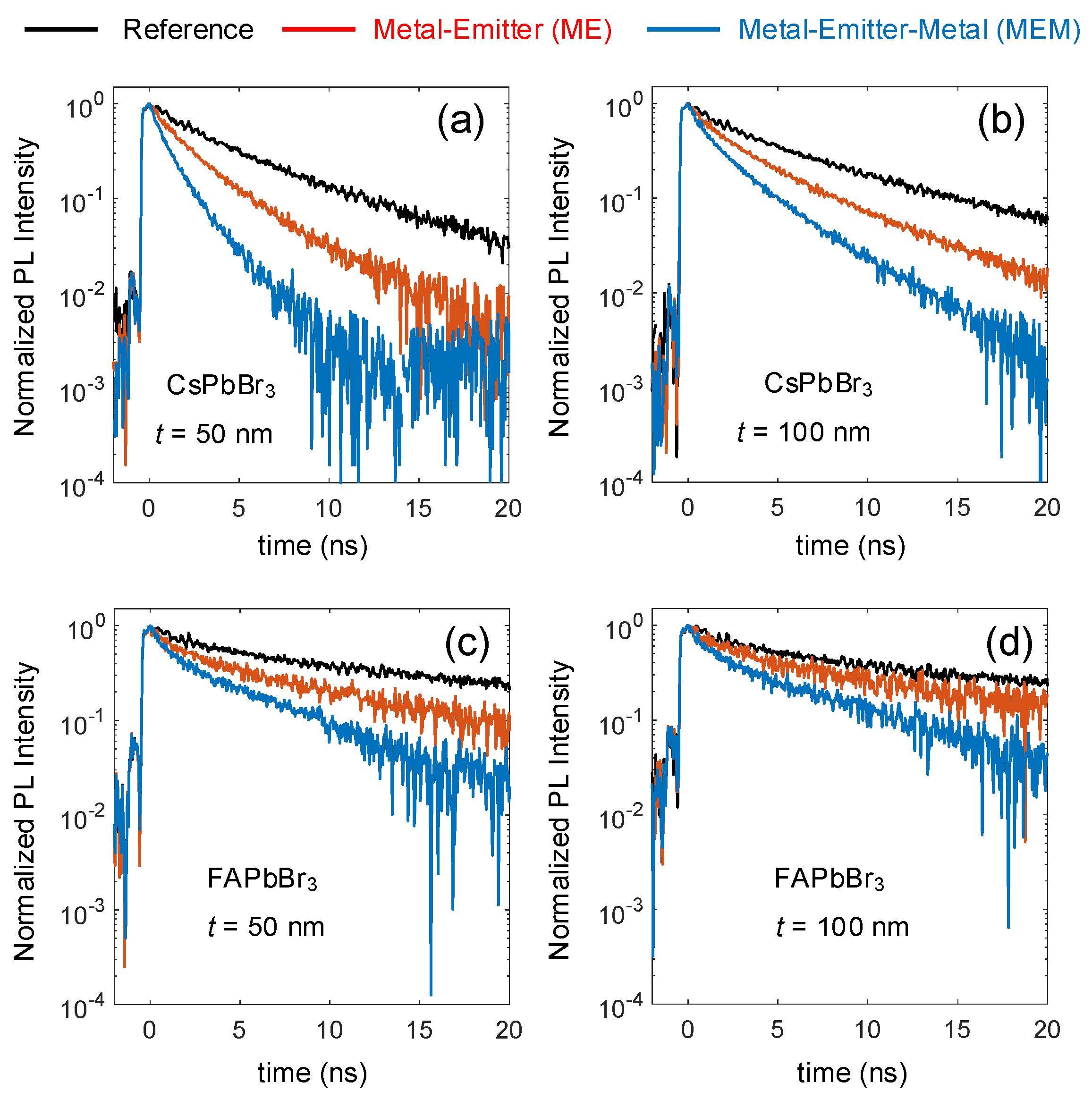
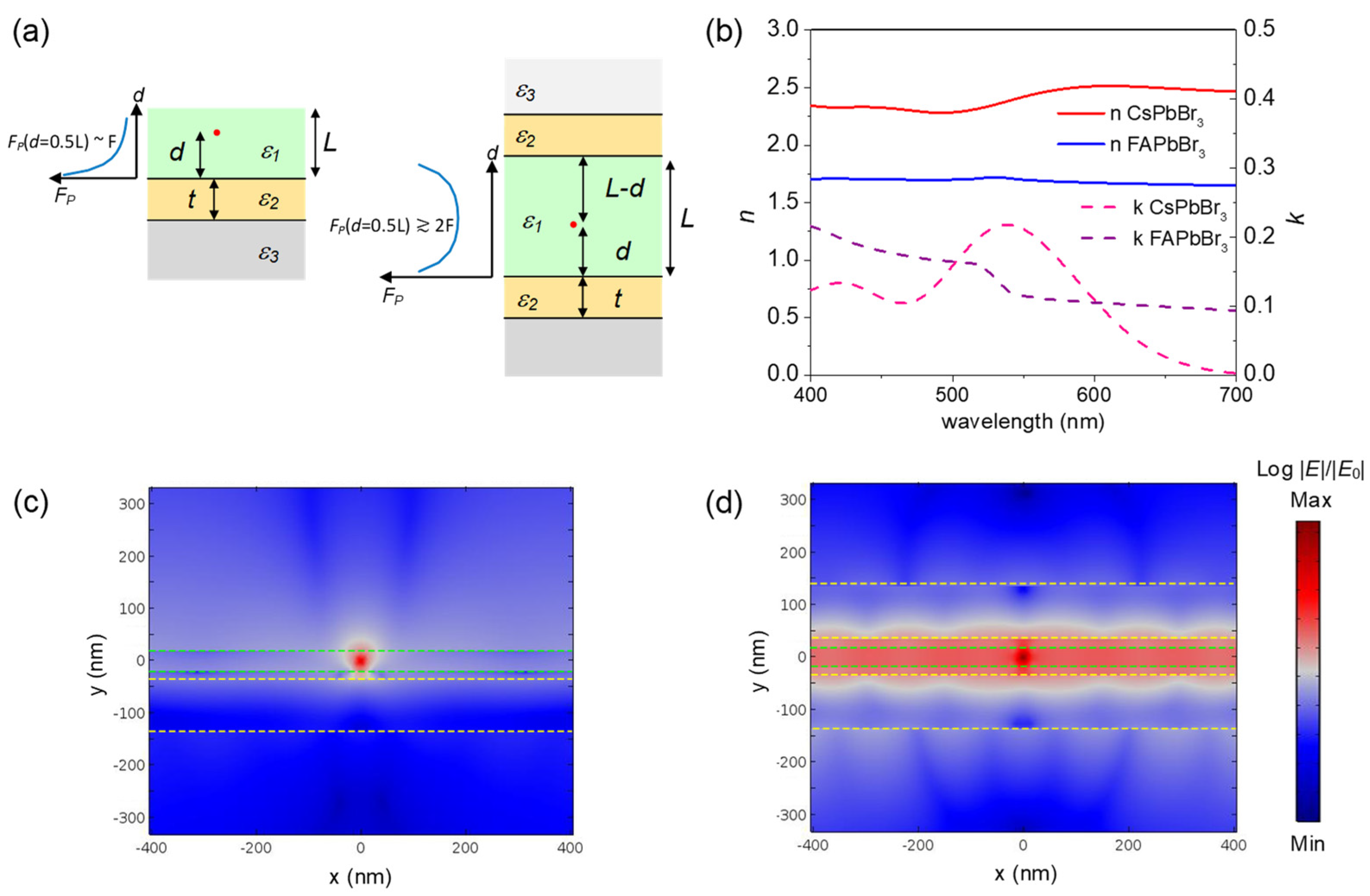
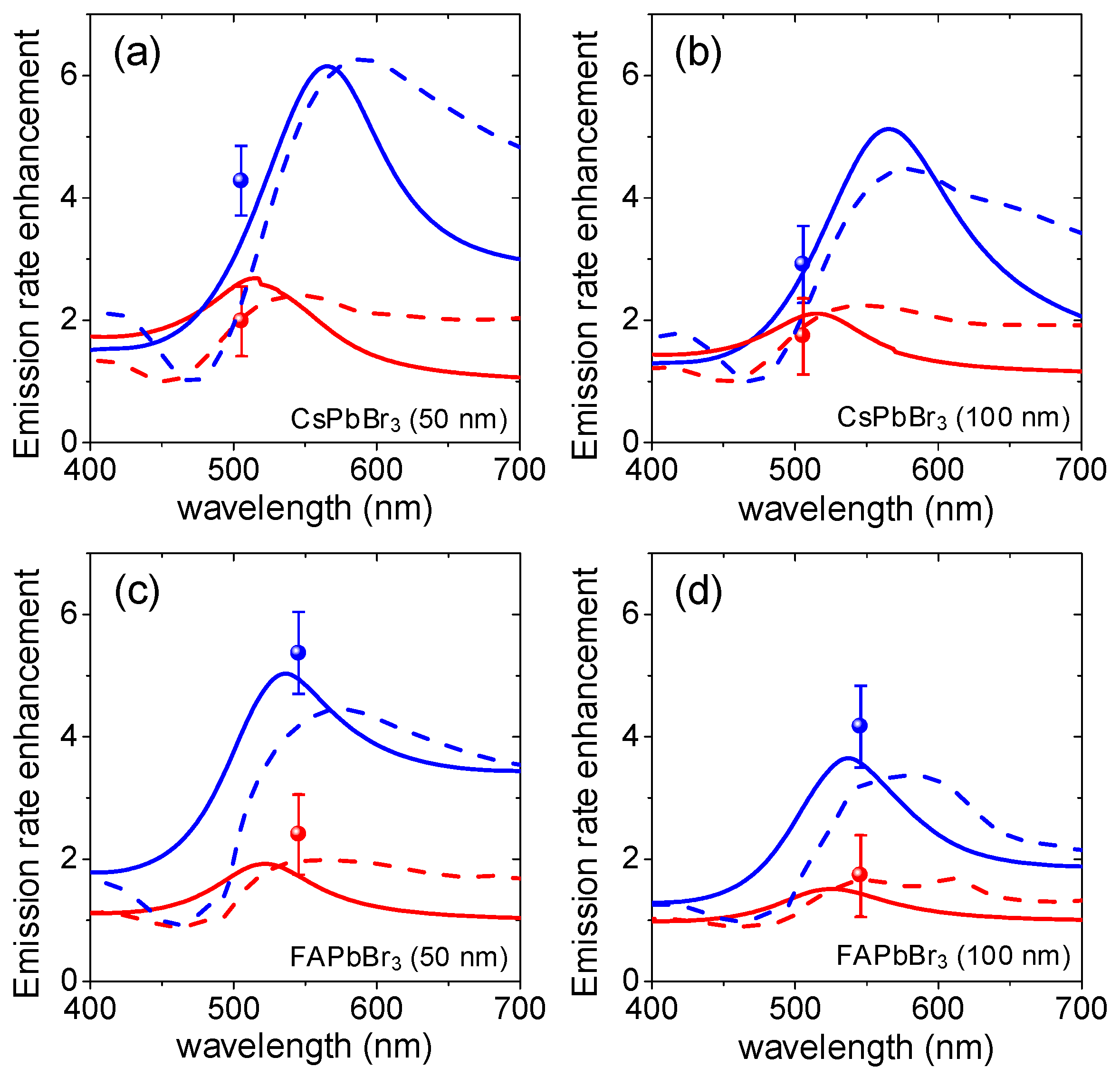
| Perovskite NC | PLR (Average ± Standard Deviation) | Emission Rate Enhancements (Average ± Standard Deviation) | ||
|---|---|---|---|---|
| Single-Au-PS | Double-Au-PS | Single-Au-PS | Double-Au-PS | |
| CsPbBr3 (50 nm) | 1.13 ± 0.11 | 1.23 ± 0.12 | 2.00 ± 0.57 | 4.28 ± 0.57 |
| CsPbBr3 (100 nm) | 1.08 ± 0.11 | 1.18 ± 0.11 | 1.76 ± 0.62 | 2.92 ± 0.63 |
| FAPbBr3 (50 nm) | 1.41 ± 0.14 | 1.91 ± 0.19 | 2.42 ± 0.66 | 5.38 ± 0.67 |
| FAPbBr3 (100 nm) | 1.21 ± 0.12 | 1.42 ± 0.14 | 1.75 ± 0.66 | 4.18 ± 0.67 |
Publisher’s Note: MDPI stays neutral with regard to jurisdictional claims in published maps and institutional affiliations. |
© 2020 by the authors. Licensee MDPI, Basel, Switzerland. This article is an open access article distributed under the terms and conditions of the Creative Commons Attribution (CC BY) license (http://creativecommons.org/licenses/by/4.0/).
Share and Cite
Tjahjana, L.; Lee, K.; Chin, X.Y.; Tobing, L.Y.M.; Adhyaksa, G.W.P.; Zhang, D.H.; Birowosuto, M.D.; Wang, H. Controlling Spontaneous Emission from Perovskite Nanocrystals with Metal–Emitter–Metal Nanostructures. Crystals 2021, 11, 1. https://doi.org/10.3390/cryst11010001
Tjahjana L, Lee K, Chin XY, Tobing LYM, Adhyaksa GWP, Zhang DH, Birowosuto MD, Wang H. Controlling Spontaneous Emission from Perovskite Nanocrystals with Metal–Emitter–Metal Nanostructures. Crystals. 2021; 11(1):1. https://doi.org/10.3390/cryst11010001
Chicago/Turabian StyleTjahjana, Liliana, Kwan Lee, Xin Yu Chin, Landobasa Y.M. Tobing, Gede W.P. Adhyaksa, Dao Hua Zhang, Muhammad Danang Birowosuto, and Hong Wang. 2021. "Controlling Spontaneous Emission from Perovskite Nanocrystals with Metal–Emitter–Metal Nanostructures" Crystals 11, no. 1: 1. https://doi.org/10.3390/cryst11010001






